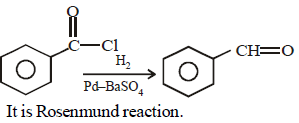All Exams >
NEET >
1 Year Dropper Course for NEET >
All Questions
All questions of Aldehydes, Ketones and Carboxylic Acids for NEET Exam
The IUPAC name of CH3CHO is:- a)Acetaldehyde
- b)Ethanal
- c)Formaldehyde
- d)Methanal
Correct answer is option 'A'. Can you explain this answer?
The IUPAC name of CH3CHO is:
a)
Acetaldehyde
b)
Ethanal
c)
Formaldehyde
d)
Methanal

|
Ambition Institute answered |
- The functional group is an aldehyde; −CHO and the given compound has two carbon atoms.
- Thus, the IUPAC name of the compound is ethanal.
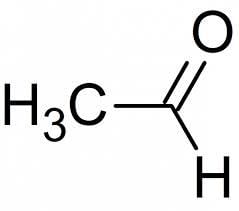
Write the IUPAC name of (CH3)2CHCHO?- a)2,2-Dimethylpropanal
- b)3-Hydroxypropanal
- c)But-3-en-2-one
- d)None of these
Correct answer is option 'D'. Can you explain this answer?
Write the IUPAC name of (CH3)2CHCHO?
a)
2,2-Dimethylpropanal
b)
3-Hydroxypropanal
c)
But-3-en-2-one
d)
None of these
|
|
Neha Sharma answered |
The IUPAC name of (CH3)2CHCHO is 2-methylpropanal and its chemical name is Isobutyraldehyde.
Which of the following statements are correct in case of the carbonyl bond between carbon and oxygen?- a)Carbon is the nucleophilic centre and Oxygen is the electrophilic centre.
- b)Oxygen is the nucleophilic centre and Carbon is the electrophilic centre.
- c)Carbon and Oxygen double bond is polarised.
- d)Both ‘b’ and ‘c’ are correct
Correct answer is option 'C'. Can you explain this answer?
Which of the following statements are correct in case of the carbonyl bond between carbon and oxygen?
a)
Carbon is the nucleophilic centre and Oxygen is the electrophilic centre.
b)
Oxygen is the nucleophilic centre and Carbon is the electrophilic centre.
c)
Carbon and Oxygen double bond is polarised.
d)
Both ‘b’ and ‘c’ are correct
|
|
Nandini Patel answered |
The double bonds in alkenes and double bonds in carbonyl groups are VERY different in terms of reactivity. The C=C is less reactive due to C=O electronegativity attributed to the oxygen and its two lone pairs of electrons. One pair of the oxygen lone pairs are located in 2s while the other pair are in 2p orbital where its axis is directed perpendicular to the direction of the pi orbitals. The Carbonyl groups properties are directly tied to its electronic structure as well as geometric positioning. For example, the electronegativity of oxygen also polarizes the pi bond allowing the single bonded substituent connected to become electron withdrawing.
Which of the following statement about C=O and C=C is correct?- a)Both consist of a sigma and pi bond
- b)C=O is polar but C=C is non-polar
- c)Both a and b are correct
- d)Both C=O and C=C undergo nucleophilic addition reactions
Correct answer is option 'C'. Can you explain this answer?
Which of the following statement about C=O and C=C is correct?
a)
Both consist of a sigma and pi bond
b)
C=O is polar but C=C is non-polar
c)
Both a and b are correct
d)
Both C=O and C=C undergo nucleophilic addition reactions

|
Knowledge Hub answered |
- The first bond formed is a sigma bind and the second one is a pi bond.
- O has a higher electronegativity than C and hence the electron cloud will be shifted towards the O atom, making the compound polar.
- This is not possible in C=C.
Among the following functional groups, which of these is not a carbonyl compound?- a)alcohols
- b)aldehydes
- c)Carboxylic acid
- d)ketones
Correct answer is option 'A'. Can you explain this answer?
Among the following functional groups, which of these is not a carbonyl compound?
a)
alcohols
b)
aldehydes
c)
Carboxylic acid
d)
ketones
|
|
Pari answered |
In carbonyl compound C=O is present bt in alchol OH is present. So alchol is not a carbonyl compound
Acetone is isomeric to:- a)n-propyl alcohol
- b)propanal
- c)ethyl methyl ether
- d)isopropyl alcohol
Correct answer is option 'B'. Can you explain this answer?
Acetone is isomeric to:
a)
n-propyl alcohol
b)
propanal
c)
ethyl methyl ether
d)
isopropyl alcohol
|
|
Lavanya Menon answered |
Acetone (CH3COCH3) and Propanal (CH3CH2CHO) are functional isomers.
- Acetone:
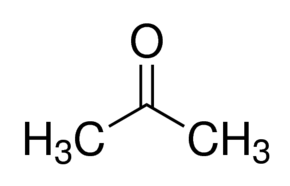
- Propanal:

Propanone and prop-2-en-1-ol are examples of which type of isomerism?
- a)Functional isomers
- b)Chain isomers
- c)Tautomers
- d)Position isomers
Correct answer is option 'A'. Can you explain this answer?
Propanone and prop-2-en-1-ol are examples of which type of isomerism?
a)
Functional isomers
b)
Chain isomers
c)
Tautomers
d)
Position isomers
|
|
Gayatri Banerjee answered |
Functional isomers
Explanation: Propanone (CH3COCH3) and prop-2-en-1-ol (CH2=CHCH2OH) are examples of functional isomers because they have the same molecular formula (C3H6O) but different functional groups. Propanone has a carbonyl group (C=O) while prop-2-en-1-ol has an alcohol group (OH) and a carbon-carbon double bond (C=C).
Explanation: Propanone (CH3COCH3) and prop-2-en-1-ol (CH2=CHCH2OH) are examples of functional isomers because they have the same molecular formula (C3H6O) but different functional groups. Propanone has a carbonyl group (C=O) while prop-2-en-1-ol has an alcohol group (OH) and a carbon-carbon double bond (C=C).
How many structural isomers can compound with molecular formula ‘C3H6O’ have?- a)6
- b)4
- c)5
- d)11
Correct answer is option 'D'. Can you explain this answer?
How many structural isomers can compound with molecular formula ‘C3H6O’ have?
a)
6
b)
4
c)
5
d)
11
|
|
Ritu Singh answered |
The Isomers of C3H6O include:
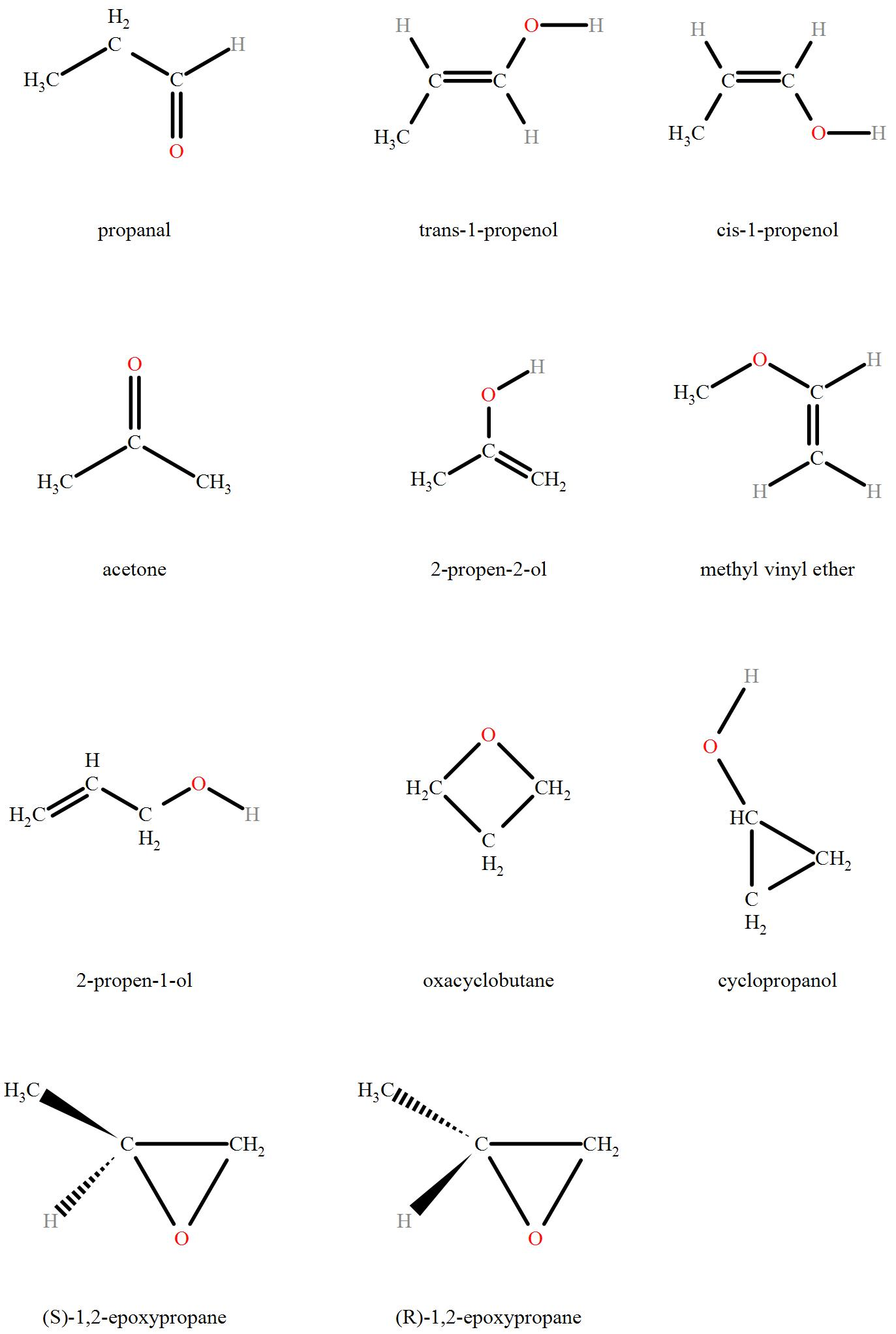
Hence we can see that a total of 11 isomers of C3H6O are possible.
What is the common name of 2-methyl-propanal?- a)formaldehyde
- b)Isobutyraldehyde
- c)carbaldehyde
- d)acetaldehyde
Correct answer is 'B'. Can you explain this answer?
What is the common name of 2-methyl-propanal?
a)
formaldehyde
b)
Isobutyraldehyde
c)
carbaldehyde
d)
acetaldehyde
|
|
Nikita Singh answered |
- Isobutyraldehyde is the chemical compound with the formula (CH₃)₂CHCHO.

- It is an aldehyde, isomeric with n-butyraldehyde.
- Isobutyraldehyde is manufactured, often as a side-product, by the hydroformylation of propene. Its odour is described as that of wet cereal or straw.
CH3CHO and C6H5CH2CHO can be distinguished chemically by: [2012]
- a)Benedict test
- b)Iodoform test
- c)Tollen’s reagent test
- d)Fehling solution test
Correct answer is option 'B'. Can you explain this answer?
CH3CHO and C6H5CH2CHO can be distinguished chemically by: [2012]
a)
Benedict test
b)
Iodoform test
c)
Tollen’s reagent test
d)
Fehling solution test

|
Ayush Choudhury answered |
CH3CHO and C6H5CH2CHO both are aldehydes so they can give the test of Tollen’s reagent, Fehling's solution and Benedict’s solution.
The carbonyl compounds with the structure R-CO-CH3 can only give the Iodoform test.
CH3CHO is the only aldehyde which reacts with NaOH and I2 to give yellow crystals of Iodoform while C6H5CH2CHO doesn’t react with it.
So, the iodoform test is used to distinguish between CH3CHO and C6H5CH2CHO compounds.
CH3CHO + 3I2 + 4NaOH ⟶ CHI3 + HCOONa + 3NaI +3H2O
C6H5CH2CHO + I2 + 4NaOH⟶ No reaction.
Propionic acid with Br2|P yields a dibromo product. Its structure would be: [2009]- a)

- b)CH2Br – CH2 – COBr
- c)

- d)CH2 Br – CHBr – COOH
Correct answer is option 'C'. Can you explain this answer?
Propionic acid with Br2|P yields a dibromo product. Its structure would be: [2009]
a)

b)
CH2Br – CH2 – COBr
c)

d)
CH2 Br – CHBr – COOH

|
Anand Jain answered |
This reaction is an example of Hell - Volhard
Zelinsky reaction. In this reaction acids
containing α– H on treatment with X2 /P
give di-halo substituted acid.
Zelinsky reaction. In this reaction acids
containing α– H on treatment with X2 /P
give di-halo substituted acid.

Self condensation of two moles of ethyl acetatein presence of sodium ethoxide yields [2006]- a)acetoacetic ester
- b)methyl acetoacetate
- c)ethyl propionate
- d)ethyl butyrate
Correct answer is option 'A'. Can you explain this answer?
Self condensation of two moles of ethyl acetatein presence of sodium ethoxide yields [2006]
a)
acetoacetic ester
b)
methyl acetoacetate
c)
ethyl propionate
d)
ethyl butyrate

|
Ishani Nambiar answered |
It is an example of Claisen condensation. The
product is acetoacetic ester.
product is acetoacetic ester.

CH3CHO and C6H5CH2CHO can be distinguished chemically by:- a)Benedict test
- b)Iodoform test
- c)Tollen's reagent test
- d)None of these
Correct answer is option 'B'. Can you explain this answer?
CH3CHO and C6H5CH2CHO can be distinguished chemically by:
a)
Benedict test
b)
Iodoform test
c)
Tollen's reagent test
d)
None of these

|
Samridhi Bajaj answered |
CH3CHO will give iodoform test and C6H5CH2CHO will not give iodoform test.
A hydrocarbon A (C10H18) is capable of showing both enantiomerism as well as diastereomerism. Treatment of A either with HgSO4 / H2SO4 or B2H6 / H2O2 -NaOH results in the same carbonyl compound B. Also, C can also be obtained as one of the product in the following reaction.
C can also be obtained as one of the product in the following reaction. Consider the reaction given below,
Consider the reaction given below, Q. How many different alcohols are expected?
Q. How many different alcohols are expected?- a)1
- b)2
- c)3
- d)4
Correct answer is option 'D'. Can you explain this answer?
A hydrocarbon A (C10H18) is capable of showing both enantiomerism as well as diastereomerism. Treatment of A either with HgSO4 / H2SO4 or B2H6 / H2O2 -NaOH results in the same carbonyl compound B. Also,
Consider the reaction given below,
Q.
How many different alcohols are expected?
a)
1
b)
2
c)
3
d)
4

|
Yoganand Pendem answered |
C can be pentanal or 2- Me butanal .Both on rxn with CH3MgBr followed by hydrolysis yield enantiomeric pair of secondary alcohols.So a total of 2+2=4 different alcohols are formed.
Only One Option Correct TypeDirection (Q, Nos. 1-9) This section contains 9 multiple choice questions. Each question has four choices (a), (b), (c) and (d), out of which ONLY ONE is correct.Q. Which of the following will give a racemic mixture on reduction with NaBH4 followed by acid work-up?- a)

- b)

- c)

- d)

Correct answer is option 'B'. Can you explain this answer?
Only One Option Correct Type
Direction (Q, Nos. 1-9) This section contains 9 multiple choice questions. Each question has four choices (a), (b), (c) and (d), out of which ONLY ONE is correct.
Q.
Which of the following will give a racemic mixture on reduction with NaBH4 followed by acid work-up?
a)
b)
c)
d)

|
Amisha answered |
The ans is B . coz after the action of NaBH4 ,chiral carbon is present only in the product of B.And hence it can give both R and S configuration.
The incorrect statement regarding oxo process for synthesis of an aldehyde is- a)Mixture of CO and H2 is allowed to react with an alkene
- b)Co2(CO)8 may be used as a catalyst
- c)[Co(CO)4H] may act as a catalyst
- d)This process can also be used in the same manner for the synthesis of ketone
Correct answer is option 'D'. Can you explain this answer?
The incorrect statement regarding oxo process for synthesis of an aldehyde is
a)
Mixture of CO and H2 is allowed to react with an alkene
b)
Co2(CO)8 may be used as a catalyst
c)
[Co(CO)4H] may act as a catalyst
d)
This process can also be used in the same manner for the synthesis of ketone

|
Yoganand Pendem answered |
Oxo process involves formulation of alkene to form aldehyde only not ketone
The oxidation of toluene to benzoic acid can be stopped at the aldehyde stage. The reaction is called?- a)Etard reaction
- b)Stephen reaction
- c)Friedel – crafts reaction
- d)Gatterman – Koch reaction
Correct answer is option 'A'. Can you explain this answer?
The oxidation of toluene to benzoic acid can be stopped at the aldehyde stage. The reaction is called?
a)
Etard reaction
b)
Stephen reaction
c)
Friedel – crafts reaction
d)
Gatterman – Koch reaction

|
Indu Indu answered |
Red algae .it is also responsible for red colour water in mediterreian sea
In the propanoate ion- a)both the carbon – oxygen bonds are the same length.
- b)the carbon atom bears a – 1 charge.
- c)one of the oxygen atoms bears a – 1 charge
- d)the carbon – oxygen double bond is shorter.
Correct answer is option 'A'. Can you explain this answer?
In the propanoate ion
a)
both the carbon – oxygen bonds are the same length.
b)
the carbon atom bears a – 1 charge.
c)
one of the oxygen atoms bears a – 1 charge
d)
the carbon – oxygen double bond is shorter.
|
|
Vivek Rana answered |
This is because of Resonance.
Which is the most suitable reagent for the following transformation?
- a)Zn(Hg)-HCI
- b)N2H4/NaOH/Heat
- c)LiAIH4
- d)NaBH4
Correct answer is option 'A'. Can you explain this answer?
Which is the most suitable reagent for the following transformation?
a)
Zn(Hg)-HCI
b)
N2H4/NaOH/Heat
c)
LiAIH4
d)
NaBH4
|
|
Geetika Shah answered |
Clemmensen reduction is suitable for reductio n of carbonyls containing additional acidic functional group.
Arrange the following compounds in decreasing order of their acid strength: i) trichloroacetic acid ii) trifluoroacetic acid iii) acetic acid and iv) formic acid- a)trifluoroacetic acid, trichloroacetic acid, formic acid and acetic acid
- b)formic acid., trifluoroacetic acid, trichloroacetic acid, and acetic acid
- c)trichloroacetic acid, trifluoroacetic acid, acetic acid and formic acid.
- d)trifluoroacetic acid, formic acid acetic acid and Propan – 1 – ol, 4 – methylphenol
Correct answer is option 'A'. Can you explain this answer?
Arrange the following compounds in decreasing order of their acid strength: i) trichloroacetic acid ii) trifluoroacetic acid iii) acetic acid and iv) formic acid
a)
trifluoroacetic acid, trichloroacetic acid, formic acid and acetic acid
b)
formic acid., trifluoroacetic acid, trichloroacetic acid, and acetic acid
c)
trichloroacetic acid, trifluoroacetic acid, acetic acid and formic acid.
d)
trifluoroacetic acid, formic acid acetic acid and Propan – 1 – ol, 4 – methylphenol
|
|
Tanuja Kapoor answered |
Acidic strength of carboxylic acid -
– More acidic than phenols or alcohols.
– Acidity increase with the presence of a group with -I effect in the alkyl group.Whereas it decreases with the presence of +I group.
– Acidity increases with increase in the number of halogen atoms on  - position.
- position.
 - position.
- position.– It decreases with increasing distance of halogen from 

– It increases with increase in the electronegativity of halogen.
- CF3COOH > CCl3COOH > HCOOH > CH3 COOH
Consider the following reaction,
(A pure enantiomer)Q. The incorrect statement regarding X is- a)It is an aldehyde
- b)Product has inverted configuration at the α-carbon
- c)X is a racemic mixture
- d)Product can be either laevorotatory or dextrorotatory isomer
Correct answer is option 'C'. Can you explain this answer?
Consider the following reaction,
(A pure enantiomer)
Q.
The incorrect statement regarding X is
a)
It is an aldehyde
b)
Product has inverted configuration at the α-carbon
c)
X is a racemic mixture
d)
Product can be either laevorotatory or dextrorotatory isomer
|
|
Om Desai answered |
X will be a pure enantiomer of aldehyde.


An organic compound A (C7H16O) shows both enantiomerism and diastereomerism. Treatment of a pure enantiomer of A with Na2CrO4 /Dil. H2SO4 gives B (C7H14O) - Also A on dehydration with concentrated H2SO4 gives a single alkene C (C7H14). Ozonolysis of C followed by work-up with Zn-H2O gives D (C5H10O) as one of the product which gives racemic mixture on reduction with NaBH4.Q. If B is reduced with LiAIH4 followed by acid hydrolysis will give- a)a pure enantiomer
- b)a racemic mixture
- c)a pair of diastereomers
- d)an achiral alcohol
Correct answer is option 'C'. Can you explain this answer?
An organic compound A (C7H16O) shows both enantiomerism and diastereomerism. Treatment of a pure enantiomer of A with Na2CrO4 /Dil. H2SO4 gives B (C7H14O) - Also A on dehydration with concentrated H2SO4 gives a single alkene C (C7H14). Ozonolysis of C followed by work-up with Zn-H2O gives D (C5H10O) as one of the product which gives racemic mixture on reduction with NaBH4.
Q.
If B is reduced with LiAIH4 followed by acid hydrolysis will give
a)
a pure enantiomer
b)
a racemic mixture
c)
a pair of diastereomers
d)
an achiral alcohol
|
|
Kashish Garg answered |
Since, A is completely saturated, it must contain more than one chiral carbon atoms in order to show both enantiomerism and diastereomerism. Also, C on ozonolysis gives D (C5H10O) as one product, other product must be CH3SHO. Hence, C must be 
B is enantiomeric. If a pure enantiomer of B is reduced with LiAIH4, pair of diastereomers would be formed.

B is enantiomeric. If a pure enantiomer of B is reduced with LiAIH4, pair of diastereomers would be formed.
A strong base can abstract an α – hydrogen from- a)Alkane.
- b)Amine
- c)Ketone
- d)Alkene
Correct answer is option 'C'. Can you explain this answer?
A strong base can abstract an α – hydrogen from
a)
Alkane.
b)
Amine
c)
Ketone
d)
Alkene
|
|
Vijay Bansal answered |
After deprotonation the negative charge will be in conjugation with the pi orbital of carbonyl..so base will prefer to abstract alpha hydrogen from ketone.
In which of the following reactions, ketone is formed as the major organic product?- a)

- b)

- c)

- d)

Correct answer is option 'A,C'. Can you explain this answer?
In which of the following reactions, ketone is formed as the major organic product?
a)
b)
c)
d)

|
Infinity Academy answered |
If acid derivatives like nitrile, acid chlorid e or ester is taken in excess in Grignard synthesis, second addition of Grignard’s reagent on carbonyl product does not succeed and carbonyls are obtained as major products.
In option (b), carboxylic acids and in option (d), an aldehyde is formed.
In option (b), carboxylic acids and in option (d), an aldehyde is formed.
All of the following reaction gives atleast one ketone as a significant organic product except- a)

- b)

- c)

- d)

Correct answer is option 'B'. Can you explain this answer?
All of the following reaction gives atleast one ketone as a significant organic product except
a)
b)
c)
d)
|
|
Vivek Rana answered |
It gives aldehydes as major product.
What compound is produced when cyclohexene is treated with concentrated KMnO4?- a)adipic acid
- b)succinic acid
- c)hexanoic acid
- d)cyclohexanecarboxylic acid
Correct answer is option 'A'. Can you explain this answer?
What compound is produced when cyclohexene is treated with concentrated KMnO4?
a)
adipic acid
b)
succinic acid
c)
hexanoic acid
d)
cyclohexanecarboxylic acid

|
Dishani Kulkarni answered |
Conc KMnO4 will cause oxidation and ring opening forming adipic acid.
Which one of the following compounds will be most readily dehydrated? [2010]- a)

- b)

- c)

- d)

Correct answer is option 'D'. Can you explain this answer?
Which one of the following compounds will be most readily dehydrated? [2010]
a)

b)

c)

d)


|
Raghav Khanna answered |
The intermediate is carbocation which is
destabilised by C = O group (present on ��-
carbon to the –OH group) in the first three
cases. In (d), α–hydrogen is more acidic which
can be removed as water. Moreover, the
positive charge on the intermediate carbocation
is relatively away from the C = O group.
destabilised by C = O group (present on ��-
carbon to the –OH group) in the first three
cases. In (d), α–hydrogen is more acidic which
can be removed as water. Moreover, the
positive charge on the intermediate carbocation
is relatively away from the C = O group.
∴ Correct choice : (d)
Clemmensen reduction of a ketone is carried outin the presence of which of the following ? [2011]- a)Glycol with KOH
- b)Zn-Hg with HCl
- c)Li Al H4
- d)H2 and Pt as catalyst
Correct answer is option 'B'. Can you explain this answer?
Clemmensen reduction of a ketone is carried outin the presence of which of the following ? [2011]
a)
Glycol with KOH
b)
Zn-Hg with HCl
c)
Li Al H4
d)
H2 and Pt as catalyst
|
|
Sankar Banerjee answered |
Clemmensen Reduction and Its Mechanism:
The Clemmensen reduction is a chemical reaction that involves the conversion of a carbonyl group in a ketone to a methylene group using zinc amalgam and hydrochloric acid. This process is particularly effective for reducing ketones to alkanes.
Role of Zn-Hg with HCl:
- In the Clemmensen reduction, zinc amalgam (Zn-Hg) serves as the reducing agent while hydrochloric acid (HCl) acts as a catalyst.
- The reaction occurs at high temperatures, typically refluxing conditions, to facilitate the reduction of the carbonyl group.
- The zinc amalgam reacts with the carbonyl group in the ketone, leading to the formation of an alkyl zinc intermediate.
- The alkyl zinc intermediate is unstable and undergoes protonation by HCl to form the corresponding alkane.
Comparison with Other Reagents:
- Glycol with KOH is commonly used for cleaving ethers, not for the Clemmensen reduction of ketones.
- LiAlH4 is a powerful reducing agent that can reduce ketones to alcohols, but it is not typically used in the Clemmensen reduction.
- H2 and Pt as a catalyst are commonly used for hydrogenation reactions, not for the Clemmensen reduction.
In conclusion, the Clemmensen reduction of a ketone is carried out in the presence of zinc amalgam and hydrochloric acid. These reagents work together to reduce the carbonyl group in the ketone to a methylene group, producing the desired alkane product.
Which of the following reactions will not resultin the formation of carbon-carbon bonds?- a)Reimer-Tieman reaction [2010]
- b)Cannizaro reaction
- c)Wurtz reaction
- d)Friedel-Crafts acylation
Correct answer is option 'B'. Can you explain this answer?
Which of the following reactions will not resultin the formation of carbon-carbon bonds?
a)
Reimer-Tieman reaction [2010]
b)
Cannizaro reaction
c)
Wurtz reaction
d)
Friedel-Crafts acylation

|
Aashna Mukherjee answered |
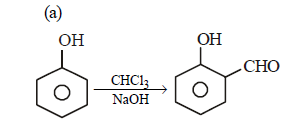


Note that new C–C bond is formed is a, c and d.
The common name for pentanedioic acid is:- a)succinic acid
- b)oxalic acid
- c)glutaric acid
- d)pimelic acid
Correct answer is option 'C'. Can you explain this answer?
The common name for pentanedioic acid is:
a)
succinic acid
b)
oxalic acid
c)
glutaric acid
d)
pimelic acid

|
Aryan Sen answered |
Pentanedioic acid is glutaric acid.
The compound obtained when acetaldehyde reacts with dilute aqueous sodium hydroxide exhibits:- a)geometrical isomerism
- b)both optical and geometrical isomerism
- c)optical isomerism.
- d)neither optical nor geometrical isomerism
Correct answer is option 'A'. Can you explain this answer?
The compound obtained when acetaldehyde reacts with dilute aqueous sodium hydroxide exhibits:
a)
geometrical isomerism
b)
both optical and geometrical isomerism
c)
optical isomerism.
d)
neither optical nor geometrical isomerism

|
Amrutha Pillai answered |
CH3CH=CHCHO is the product which is suitably substituted so will show geometrical isomer.
If glyoxal glycol is treated with a mixture of CH3MgBr and C2H5MgBr in diethyl ether followed by acid hydrolysis, how many different diols would be formed, which are simultaneously optically active?
Correct answer is '8'. Can you explain this answer?
If glyoxal glycol is treated with a mixture of CH3MgBr and C2H5MgBr in diethyl ether followed by acid hydrolysis, how many different diols would be formed, which are simultaneously optically active?

|
Ishani Yadav answered |
One pair of enantiomers for each (I) and (II) while two pairs of enantiomers for (III).
The relative reactivities of acyl compounds towardsnucleophilic substitution are in the order of : [2008]- a)Acyl chloride > Acid anhydride > Ester >Amide
- b)Ester > Acyl chloride > Amide > Acidanhydride
- c)Acid anhydride > Amide > Ester > Acylchloride
- d)Acyl chloride > Ester > Acid anhydride >Amide
Correct answer is option 'A'. Can you explain this answer?
The relative reactivities of acyl compounds towardsnucleophilic substitution are in the order of : [2008]
a)
Acyl chloride > Acid anhydride > Ester >Amide
b)
Ester > Acyl chloride > Amide > Acidanhydride
c)
Acid anhydride > Amide > Ester > Acylchloride
d)
Acyl chloride > Ester > Acid anhydride >Amide

|
Diya Datta answered |
The relative reactivities of acyl compounds
towards nucleophilic substitution follow
the order Acyl halides > Acid anhydride >
Ester > Amide. Thus the correct answer is
(a).
towards nucleophilic substitution follow
the order Acyl halides > Acid anhydride >
Ester > Amide. Thus the correct answer is
(a).
An organic compound ‘A’ on treatment with NH3 gives ‘B’ which on heating gives ‘C’, ‘C’ whentreated with Br2 in the presence of KOH produces ethylamine. Compound ‘A’ is:[2011 M]- a)CH3COOH
- b)CH3 CH2 CH2 COOH
- c)

- d)CH3CH2COOH
Correct answer is option 'D'. Can you explain this answer?
An organic compound ‘A’ on treatment with NH3 gives ‘B’ which on heating gives ‘C’, ‘C’ whentreated with Br2 in the presence of KOH produces ethylamine. Compound ‘A’ is:[2011 M]
a)
CH3COOH
b)
CH3 CH2 CH2 COOH
c)

d)
CH3CH2COOH

|
Surbhi Das answered |
Since, C when heated with Br2 in presence
of KOH produces ethylamine, hence it must
be propanamide and hence the organic
compound (A) will be propanoic acid. The
reactions follows.
of KOH produces ethylamine, hence it must
be propanamide and hence the organic
compound (A) will be propanoic acid. The
reactions follows.
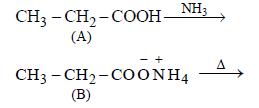
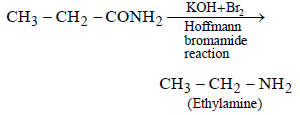
One integer Value Correct Type Direction (Q. Nos. 17-22) This section contains 6 questions. When worked out will result in an integer from 0 to 9 (both inclusive).Q. If all the aldehyde isomers of C5H10O is independently treated with HCN/NaCN solution, how many of them will give racemic mixture of cyanohydrin?
Correct answer is '3'. Can you explain this answer?
One integer Value Correct Type
Direction (Q. Nos. 17-22) This section contains 6 questions. When worked out will result in an integer from 0 to 9 (both inclusive).
Q.
If all the aldehyde isomers of C5H10O is independently treated with HCN/NaCN solution, how many of them will give racemic mixture of cyanohydrin?

|
Ishani Yadav answered |
IV is enantiomeric. Its pure enantiomer, with HCN/NaCN, would produce pair of diastereomers.
Many naturally occurring aldehydes and ketones are used in the blending of perfumes and flavouring agents. But the preferred ones are- a)higher ketones
- b)lower aldehydes
- c)lower ketones
- d)higher aldehydes
Correct answer is option 'D'. Can you explain this answer?
Many naturally occurring aldehydes and ketones are used in the blending of perfumes and flavouring agents. But the preferred ones are
a)
higher ketones
b)
lower aldehydes
c)
lower ketones
d)
higher aldehydes

|
Pritam Malik answered |
Higher aldehydes are preferred.
Which of the following is correct?
- a)On reduction any aldehyde gives secondary alcohol
- b)Reaction of vegetable oil with H2SO4 gives glycerine
- c)Alcoholic iodine with NaOH gives iodoform
- d)Sucrose on reaction with NaCl gives invert sugar
Correct answer is option 'C'. Can you explain this answer?
Which of the following is correct?
a)
On reduction any aldehyde gives secondary alcohol
b)
Reaction of vegetable oil with H2SO4 gives glycerine
c)
Alcoholic iodine with NaOH gives iodoform
d)
Sucrose on reaction with NaCl gives invert sugar

|
Pooja Pillai answered |

Which of the following represents the correctorder of the acidity in the given compounds? [2007]- a)FCH2COOH > CH3COOH > BrCH2COOH >ClCH2COOH
- b)BrCH2COOH > ClCH2COOH > FCH2COOH> CH3COOH
- c)FCH2COOH > ClCH2COOH > BrCH2COOH> CH3COOH
- d)CH3 COOH > BrCH2COOH > ClCH2COOH >FCH2COOH
Correct answer is option 'C'. Can you explain this answer?
Which of the following represents the correctorder of the acidity in the given compounds? [2007]
a)
FCH2COOH > CH3COOH > BrCH2COOH >ClCH2COOH
b)
BrCH2COOH > ClCH2COOH > FCH2COOH> CH3COOH
c)
FCH2COOH > ClCH2COOH > BrCH2COOH> CH3COOH
d)
CH3 COOH > BrCH2COOH > ClCH2COOH >FCH2COOH

|
Sneha Basak answered |
Electron withdrawing substituent (like
halogen, —NO2, C6H5 etc.) would disperse
the negative charge and hence stabilise the
carboxylate ion and thus increase acidity
of the parent acid. On the other hand,
electron-releasing substituents would
intensify the negative charge, destabilise
the carboxylate ion and thus decrease
acidity of the parent acid.
Electronegativity decreases in order
F > Cl > Br
and hence –I effect also decreases in the
same order, therefore the correct option is
halogen, —NO2, C6H5 etc.) would disperse
the negative charge and hence stabilise the
carboxylate ion and thus increase acidity
of the parent acid. On the other hand,
electron-releasing substituents would
intensify the negative charge, destabilise
the carboxylate ion and thus decrease
acidity of the parent acid.
Electronegativity decreases in order
F > Cl > Br
and hence –I effect also decreases in the
same order, therefore the correct option is
FCH2COOH > ClCH2COOH > BrCH2COOH> CH3COOH
Only One Option Correct TypeDirection (Q. Nos. 1-12) This section contains 12 multiple choice questions. Each question has four choices (a), (b), (c) and (d), out of which ONLY ONE is correct.Q. An optically active organic compound has molecular formula C5H12O(X). X on oxidation with CrO3/H2SO4 gives an achiral C5H10O. Hence, X could be- a)

- b)

- c)

- d)

Correct answer is option 'C'. Can you explain this answer?
Only One Option Correct Type
Direction (Q. Nos. 1-12) This section contains 12 multiple choice questions. Each question has four choices (a), (b), (c) and (d), out of which ONLY ONE is correct.
Q.
An optically active organic compound has molecular formula C5H12O(X). X on oxidation with CrO3/H2SO4 gives an achiral C5H10O. Hence, X could be
a)
b)
c)
d)
|
|
Rishika Patel answered |
Oxidation of X giving ketone as well as X is chiral, it must be a secondary alcohol with a-chiral carbon.
Which reagent below cannot reduce an acid chloride to an aldehyde?- a)Pd/BaSO4
- b)Li[{(CH3)3CO}3AIH] at -80°C
- c)Na/C2H5OH
- d)[HAI {CH2CH(CH3)2}2] at - 80°C
Correct answer is option 'C'. Can you explain this answer?
Which reagent below cannot reduce an acid chloride to an aldehyde?
a)
Pd/BaSO4
b)
Li[{(CH3)3CO}3AIH] at -80°C
c)
Na/C2H5OH
d)
[HAI {CH2CH(CH3)2}2] at - 80°C
|
|
Raghavendra Rane answered |
Na /C2 H5OH further reduces aldehydes to alcohols.
Which of the following reaction will not produce an aldehyde?- a)

- b)

- c)

- d)

Correct answer is option 'C'. Can you explain this answer?
Which of the following reaction will not produce an aldehyde?
a)
b)
c)
d)
|
|
Preeti Iyer answered |
Anti vicinal-diols do not undergo oxidative cleavage with HIO4.
Chapter doubts & questions for Aldehydes, Ketones and Carboxylic Acids - 1 Year Dropper Course for NEET 2025 is part of NEET exam preparation. The chapters have been prepared according to the NEET exam syllabus. The Chapter doubts & questions, notes, tests & MCQs are made for NEET 2025 Exam. Find important definitions, questions, notes, meanings, examples, exercises, MCQs and online tests here.
Chapter doubts & questions of Aldehydes, Ketones and Carboxylic Acids - 1 Year Dropper Course for NEET in English & Hindi are available as part of NEET exam.
Download more important topics, notes, lectures and mock test series for NEET Exam by signing up for free.

Contact Support
Our team is online on weekdays between 10 AM - 7 PM
Typical reply within 3 hours
|
Free Exam Preparation
at your Fingertips!
Access Free Study Material - Test Series, Structured Courses, Free Videos & Study Notes and Prepare for Your Exam With Ease

 Join the 10M+ students on EduRev
Join the 10M+ students on EduRev
|

|
Create your account for free
OR
Forgot Password
OR
Signup to see your scores
go up
within 7 days!
within 7 days!
Takes less than 10 seconds to signup







